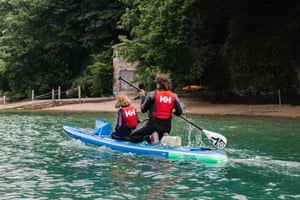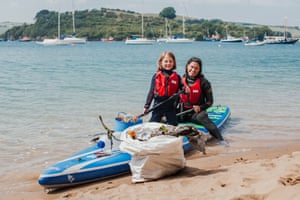One My Little Pony, two crabbing buckets, five balloons, six balls, seven straws, nine shoes, a dozen coffee cups, 20 carrier bags, 205 plastic bottles and lids, polystyrene and a huge amount of rope. That is just a fraction of what my six-year-old daughter, Ella, and I collected over the course of two days last weekend, as we paddleboarded around the Salcombe-Kingsbridge estuary in south Devon, scouring the foreshores of every creek and cove for 22 miles.
Within seconds of setting off from South Sands beach by the mouth of the estuary, we spotted a clear plastic carrier bag floating in the shallows. Marine wildlife could easily have mistaken it for a jellyfish. Ella grabbed it with a litter picker as we paddled past.
Generally, the popular sandy beaches were fairly clear of rubbish. It was further up into the estuary where we were caught by surprise. Tucked under the overhanging treeline, out of sight of tourists, we found a tranche of litter tangled in seaweed: a wheel, a wooden ladder, piping, broken glass and a stranded plastic toy dolphin. There were thousands of short strands of rope and layer upon layer of multicoloured bottle tops and shotgun cartridges among the sand and the seaweed at West Charleton, driven here by prevailing winds. Every time Ella picked up a cotton bud, I thought of Justin Hofman’s striking shot of an Indonesian seahorse swimming along, its tail wrapped around one.
We set out on the paddle to raise awareness about microplastics, highlight hotspots in the estuary and involve local schools and community groups in beach cleanups. More than 150 people got involved, including 30 of Ella’s classmates, who met us in their school uniforms for a mucky beach clean at the end of Batson Creek.
Each year, more than 8m tonnes of plastic enters our seas. It has been estimated that 100,000 marine mammals and turtles and 1m seabirds die annually as a result of entanglement or suffocation caused by plastic debris – think of the pilot whale in Thailand that died earlier this month after swallowing 80 plastic bags, or the Laysan albatross chicks on Midway Island fed regurgitated plastic by their well-meaning parents, their stomachs filling up with items as big as inkjet cartridges. About 60% of plastic is single-use, thrown away after being useful for only a few moments. In the past 10 years, humans have produced more plastic than during the previous century.

My family and I love being by the sea in Salcombe, boating, swimming, building sandcastles and exploring the creeks. The estuary is classified as a local nature reserve and it sits within the South Devon Area of Outstanding Natural Beauty. Without a river feeding into it – the naturally sheltered harbour is a tidal inlet filled by many small streams – Salcombe is technically a “ria”, or drowned valley.
In the sandy shallows, the eelgrass beds are a hotspot for breeding seahorses, while dolphins, porpoises and basking sharks swim close by in the summer months and grey seals bob about in the quieter winter months. Twice a day, at low tide, the nutrient-rich exposed mudflats become a haven for wading birds such as the curlew, with its distinctive curved bill, little egrets, which nest in the trees along the water’s edge, and shelducks, which burrow in disused rabbit holes up the creeks. Beneath the surface, rocks and pontoons teem with life – bright-red beadlet anemones, corals, sponges and fish, scallops and spider crabs – and North Sands and South Sands are rockpooling paradises on a low spring tide.
But plastic pollution is ubiquitous. Microplastics have been discovered in one-third of UK-landed fish, in mussels sampled from around the British coast, in sea salt and tap water – even in bottled drinking water. Plastic has been found in deep-sea trenches and Arctic ice sheets. Personally, the madness truly hit home when I found a sealed plastic packet of smoked salmon floating in Salcombe estuary a few years ago.
I became increasingly concerned by the fragments of plastic and polystyrene we would find caught up in the seaweed along the tideline, but this journey began properly last summer, when I came across Kids Against Plastic, a national movement set up by two sisters. “It’s an environmental disaster that we’re all growing up experiencing,” says 14-year-old Amy Meek. Ella Meek, 12, explains the “Plastic Clever” mindset: “We aren’t forcing people to be plastic free; that’s almost impossible. That’s why we want people to be Plastic Clever: a simpler, easier and more effective way of using less plastic. It involves cutting out unnecessary plastic, avoiding the big four polluters – plastic cups and lids, straws, bottles and carrier bags – and choosing reusables instead.”

Millions of these plastic items are used fleetingly, but stay in our environment for centuries. By providing alternatives to throwaway plastic items and encouraging customers to commit to reusable options, cafes, hotels, restaurants and pubs can achieve Plastic Clever status.
Like the Meek sisters, we felt overwhelmed at the sheer scale of plastic pollution and felt compelled to try to improve things on our home patch by cutting down on disposable plastics at source. Our hope is to encourage the 90 or so businesses in Salcombe to adopt the Plastic Clever mindset and put the area on the map for the best possible reason – as a leading example of successful and effective ecotourism.
Wherever you live in the UK, you are never more than 70 miles from the coast. We are all connected to the ocean via our rivers, waterways and canals, so we share a responsibility to stop this flow of plastic into the sea. Plastic is not inherently bad, but our throwaway use of it, driven by a widespread, commercially driven thirst for consumption, is not sustainable.
This message was echoed in the plastic we found repeatedly along our 22-mile paddle and in the conversations we had with fellow paddlers. Stand-up paddleboard champion Marie Buchanan was shocked by the scale of the plastic pollution we saw at West Charleton marsh, halfway up the estuary between Salcombe and Kingsbridge. Buchanan trains every day on these waters, but normally she speeds past the beaches: “It felt very different to paddle slowly with a different purpose and I was amazed by how much rope and plastic litter has accumulated along the tideline here, among the seaweed. Before now, I just hadn’t stopped to notice.” Beach cleanups may not be the solution, but the experiences they offer are eye-opening and transformative.
While we found huge, old pontoons full of polystyrene in need of proper disposal, condoms and a sanitary towel on our journey, we also saw a cuttlefish swim past, goslings poking their fluffy heads above the reeds, comb jellies floating beneath the surface and a wise-looking grey heron take flight. Our paddle-and-pick mission enabled us to get a snapshot of the whole estuary and it was a privilege to spend two days exploring with Ella, taking time to slow down and notice the sunlight shining through the seaweed. This place is special – and we want to keep it this way.
Anna and Ella will host a screening of the documentary A Plastic Ocean on 19 June at Cliff House, Salcombe. Visit beplasticclever.co.uk/salcombe and follow SalcombePlasticClever on Facebook for more information.